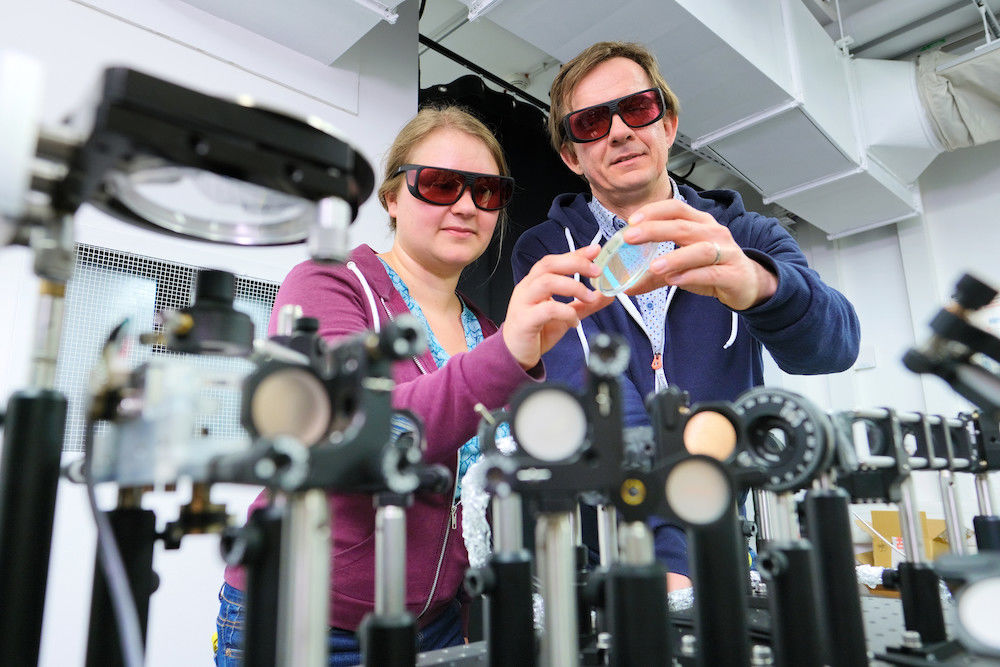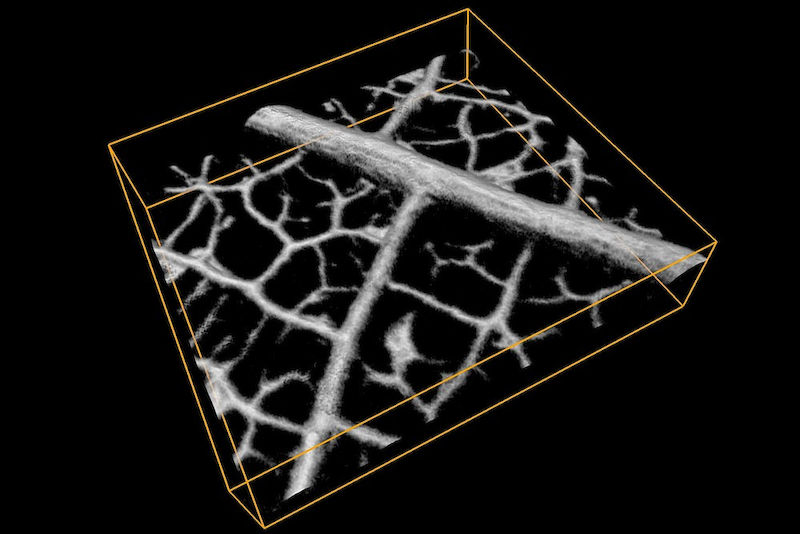How blood cells grow

At the Institute of Physics, a room-filling, complex experimental set-up consisting of all kinds of optics, mirrors and laser units testifies to the research work of the scientists. As Professor Jan Laufer explains, the photoacoustic effect used here as an imaging method for biomedicine has only been an active research topic since the mid-90s. “Photoacoustics itself, however, is a relatively old subject and is well known for its application in materials science, for example, material testing using laser-induced ultrasound. This enables us to detect possible cracks in metals, for example,” explains the 47-year-old. However, the photoacoustic effect is increasingly being used as an imaging method in medicine and biology.
The ambitious project, funded by the Deutsche Forschungsgemeinschaft (DFG) and located in Halle since 2017, is titled “Dynamically-focused photoacoustic microscopy of angiogenesis in vivo” and is run in cooperation with the Max Delbrück Center for Molecular Medicine (MDC) in Berlin. Photoacoustic microscopy is used to display high-resolution images of blood vessel networks in real time. “Figuratively speaking, we want to take a close look at the vascular system and see the conditions under which blood vessels form. The main focus of the research is on the parameters that encourage vascular growth,” emphasises Jan Laufer, who joined MLU from the Technical University of Berlin in 2017. One of these parameters is oxygen saturation in the blood. “The aim here is to microscopically determine how much oxygen the red blood cells carry and how strong the flow of these cells through a certain vessel is. Based on these findings, it will later be possible to deduce which circumstances have a favourable or debilitating effect on the sprouting of blood vessels,” says the researcher.
Knowledge for tumour research
Ulrike Pohle can quickly explain why these findings on vascular formation are so important from a medical point of view. “There are promising starting points for tumour biology and cancer research; just think about tumour growth. Tumours are nutrient-hungry tissues. And to feed they need a strong vascular network, which develops at the tumour’s command. So far, it has not been possible to sufficiently understand what is happening in the body,” explains the PhD student. It would therefore be helpful to find out how we could inhibit or even prevent the growth of the vessels attached to the tumour. But the focus is also on normal vessel formation. “For example, when it comes to injuries and healing processes.” Regardless of whether it’s a cut, laceration, graze or a burn: in the future, the vascular healing process could be accelerated if the factors that ensure rapid regeneration are known.
But how can the whole thing be visualised? “The photoacoustic effect is generally based on the generation of acoustic waves that are generated by irradiating an object with short light pulses,” explains Laufer. If these light impulses hit the tissue, for example, the optical energy is very quickly converted into heat. In turn, this heat – if the impulse was very short – promptly generates a pressure through which a sound wave is emitted. From here on, where sound comes into play, the further procedure resembles ultrasound, the well-known classic of medical imaging.
Limits not yet reached
Scientists are now taking advantage of a helpful physical property of photoacoustics. This is because the light impulses are adsorbed differently depending on the type of tissue and the colouring agents it contains. This means: vessels, muscles or tumour tissue – they can all be revealed through different ultrasound waves, which are then “intercepted” by sensors on the tissue surface and combined to form an image. Thanks to special calculation algorithms, 3D images can be reconstructed from them. The Halle-based physicists carried out the first test runs with a skeleton leaf and a zebrafish larva.
The new microscope from Halle’s medical physicists has so far fulfilled all expectations. “A normal image is produced quite quickly, a three-dimensional one is displayed in a few seconds. And yet this is not fast enough for the application, which is supposed to consist of image sequences. We are working on implementing ‘fast scanning’ so that we can really work with a high frame rate,” says Ulrike Pohle. “Only then will it be possible to track vascular processes such as blood flow in capillaries in real time.”
The scientists from Halle and Berlin can already look back on a successful two-year cooperation. There was very close cooperation during development, particularly in the initial phase. “We were able to duplicate the current device so that there is one at the Max Delbrück Center and one here at the Physics Institute,” reports Laufer. While the Berlin colleagues, most notably Professor Holger Gerhardt from the integrative vascular biology research group, are working on method development, the Halle-based physicists are in the process of further improving the technology. The microscope’s detector is a particularly innovative feature. “Where it is otherwise normal to detect ultrasound signals using piezoelectric ultrasonic transducers, we use an optical ultrasonic sensor. A big advantage is that we can bring this sensor very close to the tissue, therefore achieving higher sensitivity. If the sound wave is better detected, the image information is, of course, also more accurate,” says Laufer, adding that the possibilities are far from exhausted.
For example, there are ideas that can be used to further increase the performance, for example, the spatial resolution or depth sensitivity of the microscope. “With the current technology, we can already penetrate almost one millimetre into the tissue. However, we haven’t reached the end of the road yet. We want to look a little deeper into the tissue in the future,” says Laufer.

